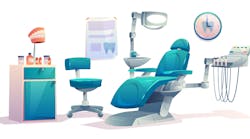All business owners require some type of equipment, and dentists are no exception. Whether just starting out and needing everything from intraoral cameras and exam chairs to waiting room furniture, or long-established with multiple locations and hundreds of employees, dentists need equipment. Equipment also breaks and wears out over time and thus needs replacing.
Innovation is ongoing and new protocols necessitate upgrading equipment so dentists can remain current in the highly competitive dental industry. I’ll examine acquiring equipment and the age-old dilemma of whether to buy or lease. Note that in this article, equipment means not just dental-related items, but also office furniture, computers, and more.
According to a 2021 survey conducted by the Equipment Leasing & Finance Foundation (ELFF), nearly 80% of businesses use financing to acquire equipment or software.1 These numbers have remained consistent since the 2019 survey. According to the survey, medical equipment is the most prevalent category to be financed, with 75% of acquisitions obtained via either loans and lines of credit or leases.1 Each has its advantages and disadvantages.
You might also be interested in: 8 questions to consider before buying equipment
Pros and cons of financing
When financing the purchase of equipment, the equipment itself typically acts as the collateral to secure the loan. Such loans are normally available in much higher amounts than those for leased equipment. An advantage of financing equipment purchases is that once the loan is paid off, the practice has an asset. This asset can be used as collateral to obtain additional and potentially more favorable loan terms for future equipment financing or even expansion of the practice. This works particularly well for items that have a long and useful life versus those that become obsolete due to use or innovation.
A disadvantage of financing equipment versus leasing includes higher up-front costs. These costs can be particularly prohibitive to new practices or those not yet generating sufficient cash flow. Purchasing is also a long-term commitment and can impair a practice’s ability to quickly pivot to new technologies as selling the equipment can be more difficult and time-consuming than amending a lease. Finally, maintenance and warranties included with the purchase may not cover the useful life of the equipment and could require additional maintenance plans.
Per the ELFF survey, leasing is the most prevalent financial tool, accounting for an estimated 26% of medical equipment acquisitions.1 Equipment leasing allows a practice to rent equipment for a time and then at the conclusion of the lease either return the equipment, renew the lease, or purchase the equipment under predetermined terms.
Pros and cons of leasing
Advantages of leasing include improved cash flow as lease terms are generally more affordable month-to-month than financing purchases. The smaller monthly payments can be a preferred approach versus a potentially large cash outlay and high monthly payments. One of the greatest appeals of leasing is its flexibility. Since leasing terms are negotiated for various durations depending on a practice’s needs, this allows the practice owner to stay abreast of current technological innovation and incremental improvements.
A short-term lease can be an effective tool for owners to try out a piece of equipment as a new dental solution or test-drive it as a new revenue stream. Finally, maintenance plans are usually included in leases, negating the administrative and financial burden associated with equipment purchases.
There are some disadvantages to leasing. Long-term leasing typically costs more than purchasing as you make payments for as long as you lease the equipment. For items you need for a longer period, leasing may not be the best solution.
Another disadvantage is that lease payments do not go toward building equity in the equipment, unless prenegotiated, or building equity in the practice. As referenced earlier, collateral is an asset for the owners when negotiating loan terms for future equipment and possible practice expansion. Finally, most leased equipment terms will not allow the owner, the lessee, to modify or customize the equipment and the lease terms may dictate the repair process.
Tax implications of leasing vs. financing
Tax implications for qualifying equipment using both methods are largely the same. With the permanent enactment of Section 179 of the Internal Revenue Code, leasing and purchase expenses for relevant, business-specific equipment are 100% tax deductible. In the event certain owned equipment does not qualify, the owner may still deduct annual depreciation, which provides a tax break depending on how much the equipment’s value declines each year.
Note that the value of the deductions requires sufficient income as an offset. Thus, deductions under Section 179 may be more beneficial for existing dental practices versus start-ups. Practice owners should always consult their tax professional when making equipment purchase and lease decisions.
For all business owners, not just those in the medical or dental space, the number and type of financing options available are some of the least understood. While the most straightforward option is for an owner to pay for everything with a full cash outlay, most will at some point seek financing. When financing, there are several lender options ranging from traditional lenders to alternative lending companies, even for acquiring used equipment.
Traditional lenders include banks and credit unions. Traditional lenders often provide better interest rates, assuming an owner is well-qualified credit wise, but they also have more stringent underwriting requirements. These tough requirements can make the approval process slower than alternative lenders. Alternative lenders, some of whom operate exclusively online, generally have streamlined application processes, which means owners could have funding for equipment in a matter of days versus weeks or months.
Lease terms through an alternative lender can be more flexible and structured to better match a practice’s needs. For example, if a new dental practice needs time to get cash flow up and running, lease payments can be structured to skip the first several payments, or the practice can make interest-only payments, followed by gradually increased payments over the next several months, year, etc.
In all financing cases, the credit score of the dental practice/practice owner will impact the interest rate of financed equipment, whether leased or purchased. The cost of capital should always be a significant factor in an owner’s decision whether to lease or purchase. A practice owner should run the numbers to determine the most cost-effective approach in the acquisition of equipment.
Purchasing equipment generally makes more sense for durable items that have long and useful lives, need customization, or for equipment that will rarely, if ever, need to be replaced. Leasing makes more sense when the equipment is subject to becoming outdated, is needed for a shorter period, or the owner wants to scale payments for a period of time.
Throughout the lifecycle of any practice, it’s likely the practice will both purchase and lease equipment. This depends on how long the practice has been in business, its size, and its unique needs at any given point. Practice owners should be aware that financing professionals can assist with navigating the complexities of leasing versus purchasing, as well as the process of selecting the most appropriate lender, whether traditional or alternative.
Editor's note: This article appeared in the October 2023 print edition of Dental Economics magazine. Dentists in North America are eligible for a complimentary print subscription. Sign up here.
Reference
1. 2022 Equipment Leasing & Finance Industry Horizon Report. Equipment Leasing & Finance Foundation. Published 2022. Accessed May 16, 2023. https://www.store.leasefoundation.org/cvweb/Portals/ELFA-LEASE/Documents/Products/ELFF.IndustryHorizonReport.FINAL.pdf







